ABrief History of LaValle, Wisconsin
Located in the south-central part of LaValle Township, on Highways 33 and 58, the village of LaValle got its name from the French term for “the valley”. Native Americans were the first to discover the lands surrounding the confluence of the Big and Little Baraboo Rivers, and established a settlement there. It was purported to be a rendezvous for the Ho Chunk from the Upper Baraboo Valley.
The first settlers arrived around 1849, drawn by the potential for good water power. J.F. Hamlin, saw that potential, and purchased the land upon which the village of LaValle would eventually stand. Hamlin, and a partner, Solon Rushmore, began construction of a dam and sawmill in 1849, with equipment being installed the following spring. The first lumber turned out by the mill went to construct a home for Hamlin.
Butterfield’s 1880 History of Sauk County notes that, “The early growth of the place was necessarily slow, situated as it was in a dense wilderness, scarcely accessible to ordinary road wagons. But the pioneer’s first pathway is always rough, and he is thankful if he can but discern the outlines of even an Indian trail.”
In 1864, J.F. Sanford purchased the mill property and added a flour-barrel manufacturing factory, which also later turned out broom handles. A large three-story grist mill with three grinding stones, was added to the facility in 1869, so villagers would no longer have to travel to Reedsburg for flour.
The old sawmill was retrofitted in 1874 to produce barrel staves. A new building in 1876 housed a steam engine to power the equipment. It burned in 1878, and the business was moved back to the old sawmill building. Five hundred staves per hour were produced–most being shipped to Chicago for flour and pork barrels. The surrounding woodland provided an ample supply of basswood and oak, which farmers were glad to supply, thereby also clearing land for crops.
By 1855, the little village was sufficiently populted that a school was begun in a small shanty. A year later, a more commodious structure was built. By
1879, there were 127 pupils in the district.
A post office was established in LaValle in 1856, with mail being brought from Reedsburg by local citizens. Area residents drew straws to see who would assume that duty for the following two weeks. Some were not happy with this arrangement, so later a full-time mail carrier was hired. When the railroad arrived in 1872, the mail service was transferred there.
With the arrival of the railroad, the little village grew proportionally. There were 4 hotels, 2 restaurants, 2 stockyards, poultry hatchery, livery stables, and general stores.
Methodist services were held in the shanty schoolhouse as early as 1856, and the Adventists also existed in limited numbers.
By 1880, the village of LaValle boasted 3 general stores, 2 hardware stores, drug store, grocery store, a hotel, 2 blacksmith shops, wagon shop, livery stable, shoe shop, millinery store, saloon, stave mill, grist mill, carding mill, a grade school, one church, Odd Fellows’ Lodge, Good Templar’s Lodge and one doctor.
Wm E. Schroeder opened a bakery in 1926, supplying the northwestern part of Sauk County with 400 loaves of bread daily. Baked goods were transported to Reedsburg, Loganville, Hillpoint, Ironton and Lime Ridge.
Electric generating equipment was installed in the mill in 1912, providing power to local customers. The mill burned in 1937, and was rebuilt. The plant continued to supply electricity until 1970.
During the latter half of the 20th Century, LaValle became a major destination for sportsmen and fishing enthusiasts with the construction of Lake Redstone in 1968, and Dutch Hollow Lake in 1972.
During the years of 2008 and 2018, major floods inundated the village, and the DNR determined that the buildings along the Baraboo River were too severely damaged for occupancy, and mandated that they be removed. In 2022, that mandate was accomplished.
May 2022








2022
May
The Flood of 2008



Sauk County Historical Society Photo Collection

The Flood of 2018

Because of the devastating floods of 2008 and 2018 which inundated the downtown area, the DNR mandated that the buildings along the river be removed. In June of 2022 that mandate was accomplished.




 The Library and Village Hall before it was deconstructed in 2009. Wollin’s Grocery store was destroyed by fire in 2016.
The Library and Village Hall before it was deconstructed in 2009. Wollin’s Grocery store was destroyed by fire in 2016.



 Abandoned buildings and Granny’s Pantry Restaurant before their deconstruction in June, 2022
Abandoned buildings and Granny’s Pantry Restaurant before their deconstruction in June, 2022



 The Treasure Mill, above, and the Old Kreutzmann Saloon as they looked before their deconstruction.
The Treasure Mill, above, and the Old Kreutzmann Saloon as they looked before their deconstruction.



 The River Mill Restaurant and Electrical Power House.
The River Mill Restaurant and Electrical Power House.
Old Library/Village Hall

The Village Hall and Library was constructed as a schoolhouse in 1890. In January of 1910 this building was removed from school house hill and set on a foundation to be used as a village hall and the back end was used as a fire engine house. This former school house was later divided as a library and village hall. The engine room had the floor raised and became part of the library. The building was removed in 2009 after the 2008 flood.
 The Library and Village Hall as it looked in 1999.
The Library and Village Hall as it looked in 1999.




 Photos by Ryan Rabuck 2009
The former library and city hall was taken down in 2009
Photos by Ryan Rabuck 2009
The former library and city hall was taken down in 2009
Wollin’s Grocery and later



Bare Necessities Market

 Photos by Ryan Rabuck
2016
The building was totally destroyed by fire in 2016
Photos by Ryan Rabuck
2016
The building was totally destroyed by fire in 2016
The remains of the store were removed and as of July, 2022, there has been no new construction on the site.




Old Legion Building



This building was once a bakery and grocery operated in 1926. The owner was William Schrorder and was called Schrorder’s Bakery and Daisy Restaurant. The bakery was equipped with a Superior Bakers Oven and had a daily output of 400 loaves of bread. Schroeder transported many of his baked goods by car to Reedsburg, Loganville, Hillpoint, and Lime Ridge. In 1930 it was sold to R.A. Nowayney and operated as the La Valle Bakery. After that, it was again a grocery store. In 1940 Carol Webb opened a printer's shop in the building, which published a local newspaper. It was closed in 1946. Hadley Blonien then opened a Firestone Service Store for one year. Upstairs, there was a three-unit apartment. Some of the other iterations of the building were: Mr. Neely offered guitar lessons there. The Legion purchased it in 1965, and Dan DeBaets purchased it in 1990s as a woodworking shop.
 The Old Legion Building as it appeared in 2002.
The Old Legion Building as it appeared in 2002.



 The old Legion building is being taken down, beginning at the rear.
The old Legion building is being taken down, beginning at the rear.




 The Daisy Restaurant was once housed in the building above, and on the previous two pages.
History of Reedsburg & the Upper Baraboo Valley Merton Krug, 1929
Garage, located at the rear of the old Legion building.
Above, the old Legion building coming down.
The Daisy Restaurant was once housed in the building above, and on the previous two pages.
History of Reedsburg & the Upper Baraboo Valley Merton Krug, 1929
Garage, located at the rear of the old Legion building.
Above, the old Legion building coming down.
This building, here in 2009, has always been a private home which ended in the flood of 2018.







 This private home along the river, was demolished in June, 2022.
This private home along the river, was demolished in June, 2022.
The brick bar on the left (1914 above & 1920s below) was one of the buildings that was torn down in June 2022. See the following pages.
Sauk County Historical Society Photo Collection




The building was taken down in June, 2022

Old Kreutzmann Saloon

Farmers coming onto main Street from the creamery would see an interesting sign on Kreutzmann Saloon's west side, proclaiming, "Your First Chance to Have a Good Glass of Lager." On the east side of the building was painted, "Your Last Chance to Have a Good Glass of Lager ! "
The Riverside Tavern was owned by Fred Briggs from 1933 to 1940 when the Dehler Brothers purchased it. They sold it to George Mason and Billy Rabuck (Mason & Rabuck Tavern). They operated it until Fred Kinney took over in 1945 to 1948. Around 1949 the building was purchased by Wenz Mihlbauer and Fred Klett. In 1970 it was operated by Wenz Mihlbauer. They later built a new Tavern across the street in the early 1970s. The old building then contained two apartments through 2021.





YOUR FIRST CHANCE FOR A GOOD GLASS OF LAGER












Granny’s Pantry Restaurant Building

This building was built by the Kinney Brothers to house a furniture store. Clyde Lobdell operated a furniture and undertaking parlor there. Helen Lobdell, who was 21 years old, was said to be youngest embalmer in the state. Lobdell also added a pool hall to the building, according to the Reedsburg Free Press Sep. 19, 1929.
Clyde Lobdell opened a barber shop in his building in 1930. Charles Craigo operated the shop for number of years, and from 1943 to 1946 the barber shop was operated by George King.
In December, 1945, Fred Briggs opened a restaurant in the former Lobdell Furniture Store. In 1947 he sold it to Elmer Gramwand, who sold it to Adam Massari around 1950. In 1965 Raymond Borchers and Delores Gudenschwager purchased it. In the early 1970s Harold Leeds took over and renamed it Granny's Pantry.
Merlin Courtier, Fred Kinney, Jack Manville, and Jean Snyder operated the restaurant until the flood of 2018, when it closed permanently. On the far right of the building, there was a small room which was used as an insurance office, and later a reality office. Below is what was left of the lunch counter in 2022.





 Above is the restaurant lunch counter. Below, is one of the upstairs rooms, in June, 2022, just before the building was demolished.
Above is the restaurant lunch counter. Below, is one of the upstairs rooms, in June, 2022, just before the building was demolished.
This elevator was located at the rear of the building. When a funeral home was housed here, it was used to bring caskets to the second floor where the deceased was prepared. Then it was lowered back down to the main floor for the visitation and funeral. The elevator was hand operated with ropes and cables.







 Granny’s Pantry as it is taken down by this excavator.
Granny’s Pantry as it is taken down by this excavator.



 The elevator cable mechanism, below, which lifted the caskets to the second floor.
The elevator cable mechanism, below, which lifted the caskets to the second floor.



 Water is sprayed on the debris, below, to keep the dust down.
Water is sprayed on the debris, below, to keep the dust down.




LaValle Electric Light Company



Victor Duddleston, who owned the mill which housed a water-driven generator, also produced electricity for the village. Originally the water wheel was shut down every evening at 11 p.m. Anyone using electric lights after that hour had to rely on kerosene lamps. The LaValle Milling Company produced the electricity for the community from 1912 until May 25, 1970. After that, the village power was supplied by the Oakdale Electric Cooperative.




 At the rear of the old mill, this building housed the water wheel (below it) and the gearing system, inside, which transferred belt power to operate the mill. The Baraboo River flows on the right.
At the rear of the old mill, this building housed the water wheel (below it) and the gearing system, inside, which transferred belt power to operate the mill. The Baraboo River flows on the right.
The Old Mill
The Mill Dam ca. 2000, before it was taken out in 2001.



 Photos from the collection of Sandy Cole
Photos from the collection of Sandy Cole
The LaValle Mills


In the year, 1849, the first settler to stake a claim in what is now the village of LaValle, was J.F. Hamlin, who built a shanty on the south side of the Baraboo River. He saw that when more settlers arrived, they would need lumber to build their new homes. So, he commenced to develop a waterpower on the river opposite his home. Hamlin, and another early settler, Mr. Rashmore, spent that summer building a dam and sawmill. This machinery included the main turbine system made with wooden teeth on a metal framework which still existed until the mill was demolished in 2022. The hardwood used to make the teeth on the gear was shipped from Maine. They boiled the wood in linseed oil and beeswax, soaking the wood for two days. The linseed oil soaks into the wood to help preserve it and beeswax acts as a water repellent. See the turbine, above.
The next spring machinery had been installed and the mill was up and running. The first lumber sawed, went into the frame house of Mr. Hamlin. He began supplying lumber to build homes and barns in the surrounding community.


J.F. Sanford took possession of the mill in 1864. He soon established a flour-barrel factory in connection with the mill, and also began making broom handles.
By 1869, Sanford saw the need for the settlers to have a way of grinding their grain into flour. So, he began building a three-story gristmill nearby, which was operated with the water power from the dam.
The sawmill had seen its day by 1874, and the old machinery was taken out of the mill, and the space was equipped to manufacture barrel staves. Needing more room, in 1876 the stave operation was moved to a new building which was erected a short distance from the dam. The operation only lasted for a year, when a fire destroyed the business. So, once again, the old sawmill was reactivated for the production of barrel staves.
After Sanford retired from the gristmill business, it passed through various owners. In 1929, it was being run by the Dudleson family and became one of the largest mills in a village the size of LaValle.
About 1911, the mill used its water power to operate a 24 kilowatt generator for the Electric Light Company, which provided power to the LaValle community. It continued until 1960 when it became the Oakdale Power Co.
Over the years, the old mill was in constant use, despite fires and changes in ownership. The mill burned down in 1937, due to a fire which began in the electric generating room. But the mill was rebuilt immediately by the Duddlestons, probably to a better state than before. The timbers are huge, 8” x l0” beams of red oak, with the framing on 12” center, all in such perfect condition, they might have been put in yesterday. There are two of them bolted together. They are 32 feet long with no splice. It’s built tough for good reason: When the mill’s 12 grain bins were filled with oats, corn and soybeans, the beams were supporting about 10 tons.
The mill continued operations through the 1900s, specializing in the grinding of stock feed, Top Notch Egg Mash, and the sale of feeds.
This barrel-making device was found in the basement of the mill that was demolished in 2022. The clamps held the staves together so that the metal hoops could be placed around them. It was saved.
The mill operated until 1999 when the property was purchased by the Sand County Conservancy around 2001 to expedite the dam removal on the Baraboo River a project which would leave the 120 mile river freeflowing again, as it had before European settlement.
The mill was bought by Mike & Jody Cummings in 1999, from the Sand County Conservancy. They turned the space into the Treasure Mill Antiques, which offered antiques, crafts and Amish furniture. They operated the antique store until 2014.

That empty mill existed until it was torn down in 2022.
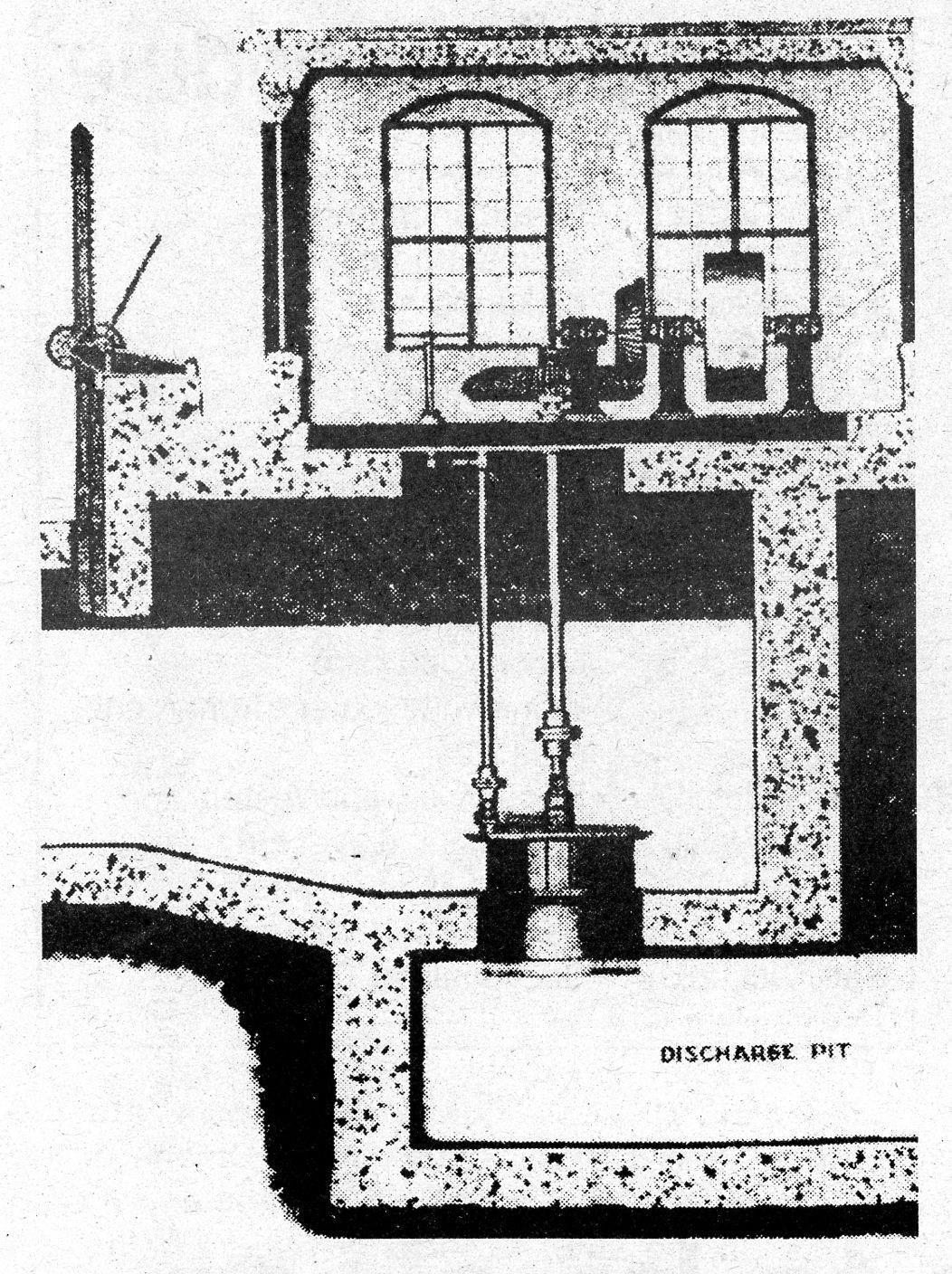 This diagram represents the way the turbine water wheel and gearing system operated to produce power to run the mill equipment and electrical generator.
Turbine
Control Shaft
Power Shaft
Pully which contained a belt that powered the mill equipment
Gate which controlled the river water which flowed past the water wheel turbine
This diagram represents the way the turbine water wheel and gearing system operated to produce power to run the mill equipment and electrical generator.
Turbine
Control Shaft
Power Shaft
Pully which contained a belt that powered the mill equipment
Gate which controlled the river water which flowed past the water wheel turbine



 This building housed the gears above the water wheel.
This building housed the gears above the water wheel.



 The teeth in this power transfer gear were made of wood.
The teeth in this power transfer gear were made of wood.



 The gear on the far right is turned by the water wheel, which then transfers that motion to the horizontal gear shaft. Pullies on the shaft then transfer that rotary motion to various equipment in the mill.
An indoor toilet was one of the luxury features inside the old mill.
The gear on the far right is turned by the water wheel, which then transfers that motion to the horizontal gear shaft. Pullies on the shaft then transfer that rotary motion to various equipment in the mill.
An indoor toilet was one of the luxury features inside the old mill.
The turbine water wheel was located near the dam in the photo below. See next page.


The shaft on the right, bottom photo, turned adjoining gears in the small room above it. That motion was then transferred to machinery throughout the mill. The thinner shaft to its left, was connected to a steering wheel-like controller which adjusted the speed of the turbine water wheel.






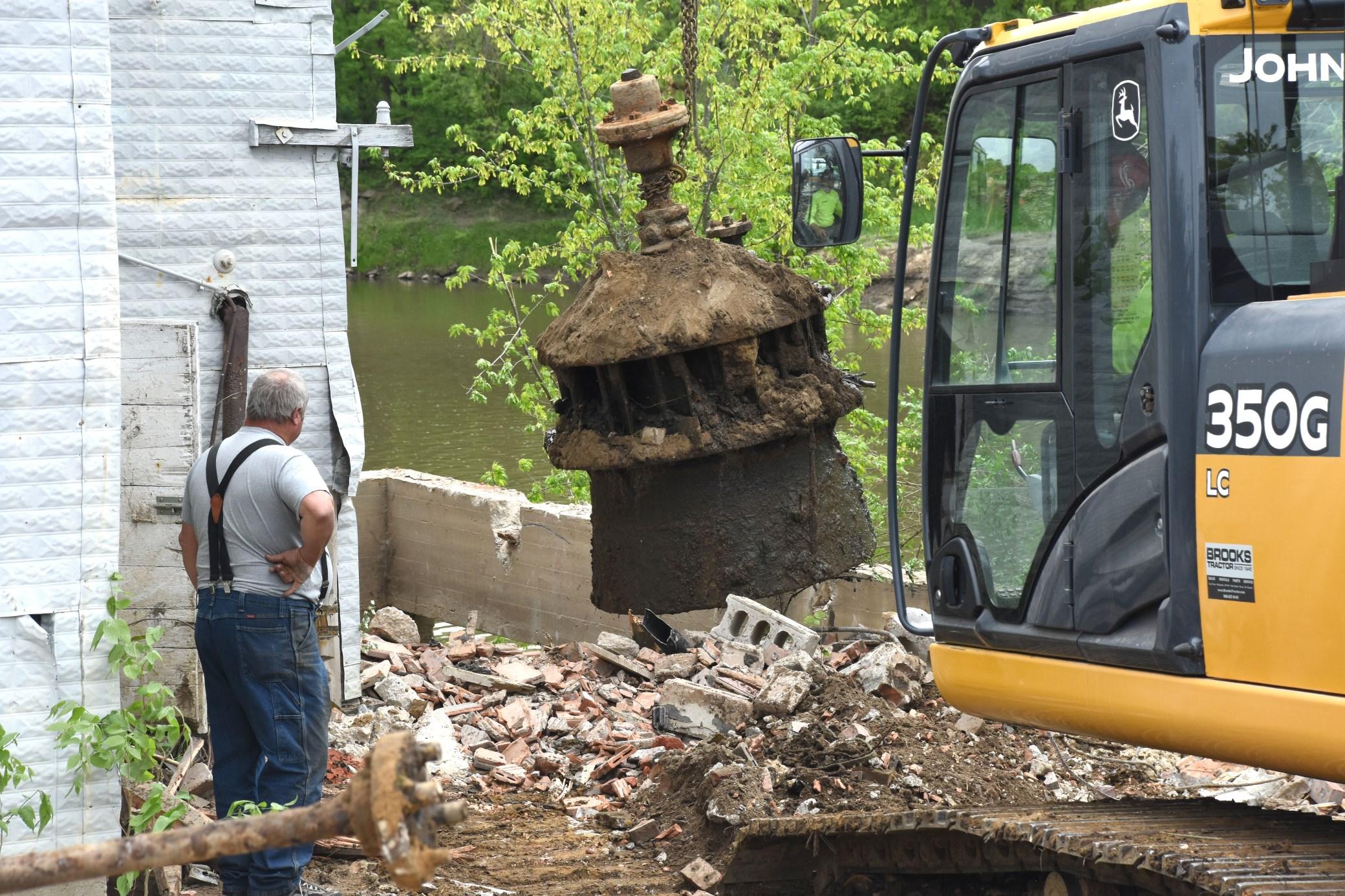 The turbine water wheel which powered the equipment in the mill.
The turbine water wheel which powered the equipment in the mill.



 Above, the basement of the mill. Below, the top half of a grain mixer.
Above, the basement of the mill. Below, the top half of a grain mixer.


 Rooms inside the Mill
Rooms inside the Mill




 Bottom half of the grain mixer.
Bottom half of the grain mixer.
The wheel below was used to open and close the duct which allowed the water turbine to produce mechanical power to operate the mill and electrical generator. See instructions below left.





Equipment in left photo, is a regulator governor to control the speed of mill machinery.




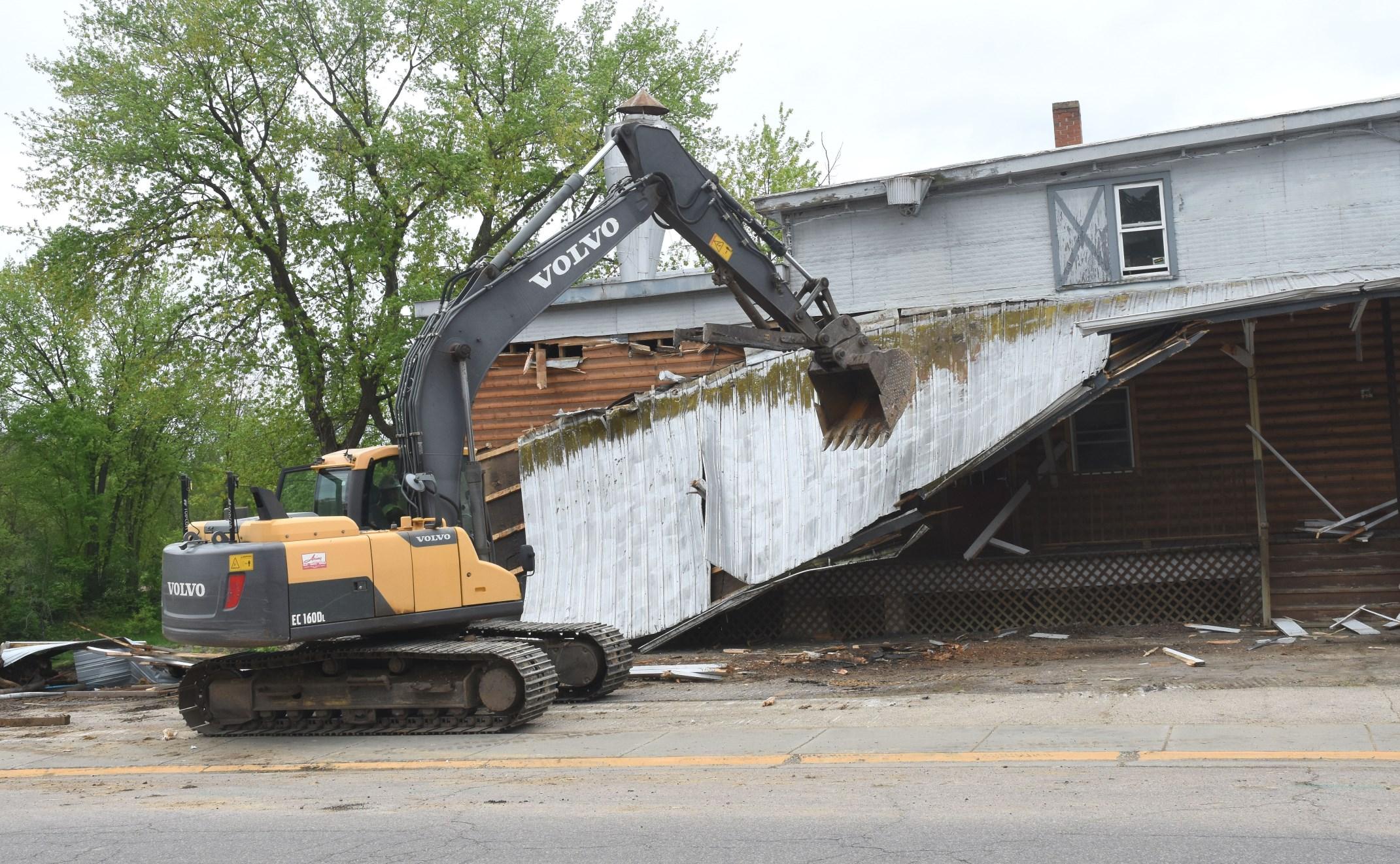 Demolition of the exterior of the Mill begins.
Demolition of the exterior of the Mill begins.










 The scattered lumber from the Mill was reclaimed and repurposed.
The scattered lumber from the Mill was reclaimed and repurposed.








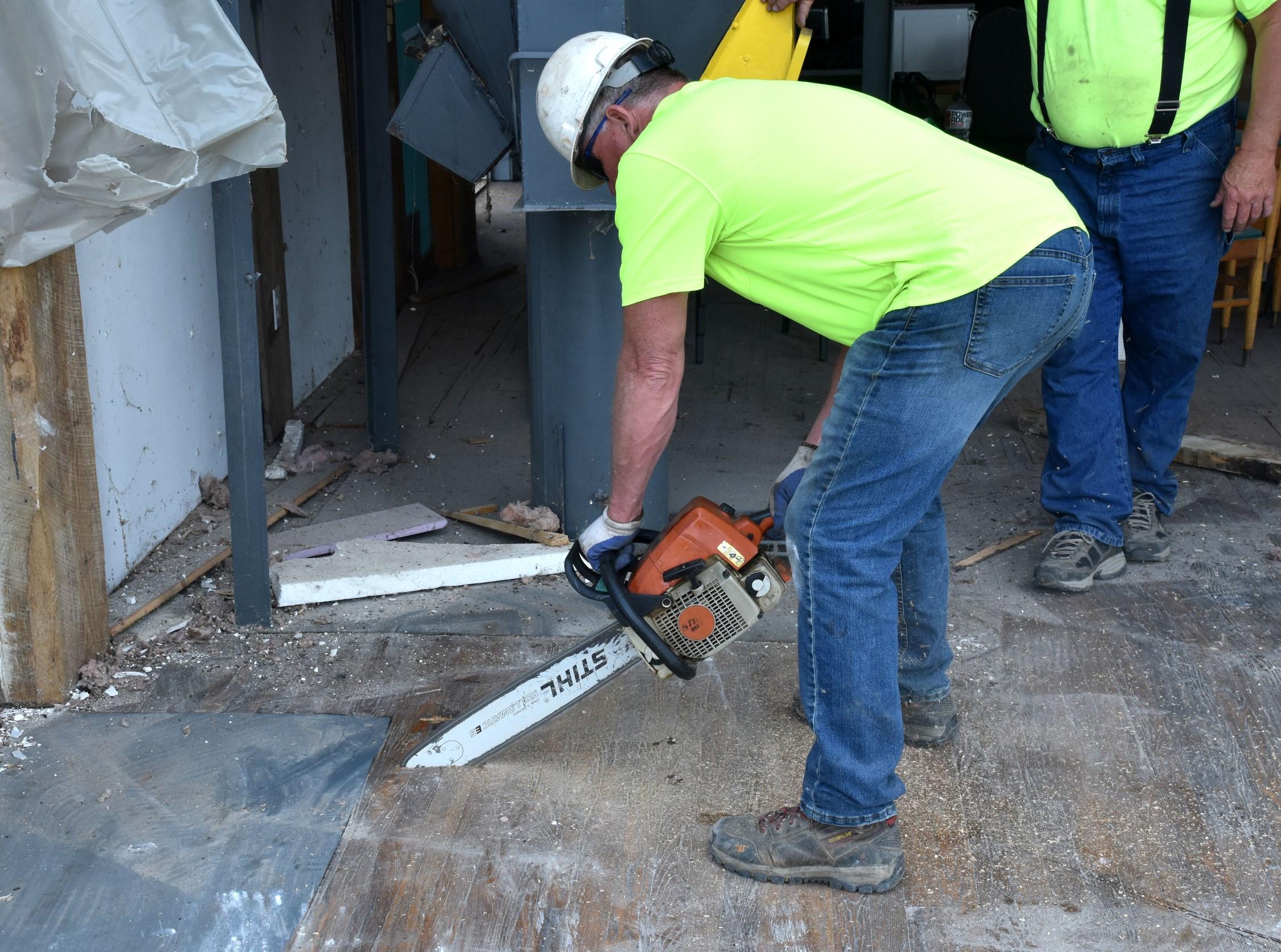












 Reclaiming the boards and timbers for recycling, below.
Reclaiming the boards and timbers for recycling, below.

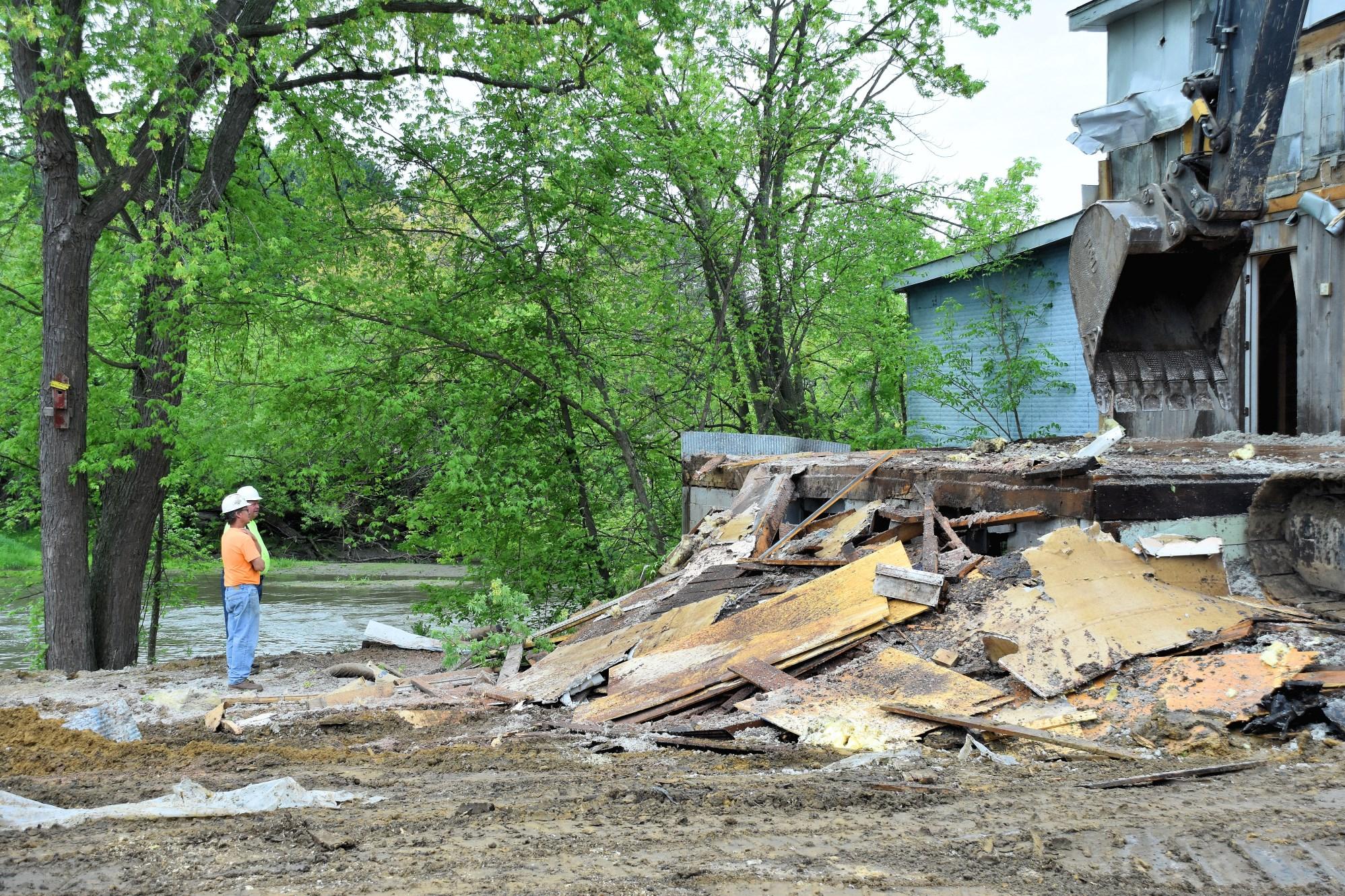







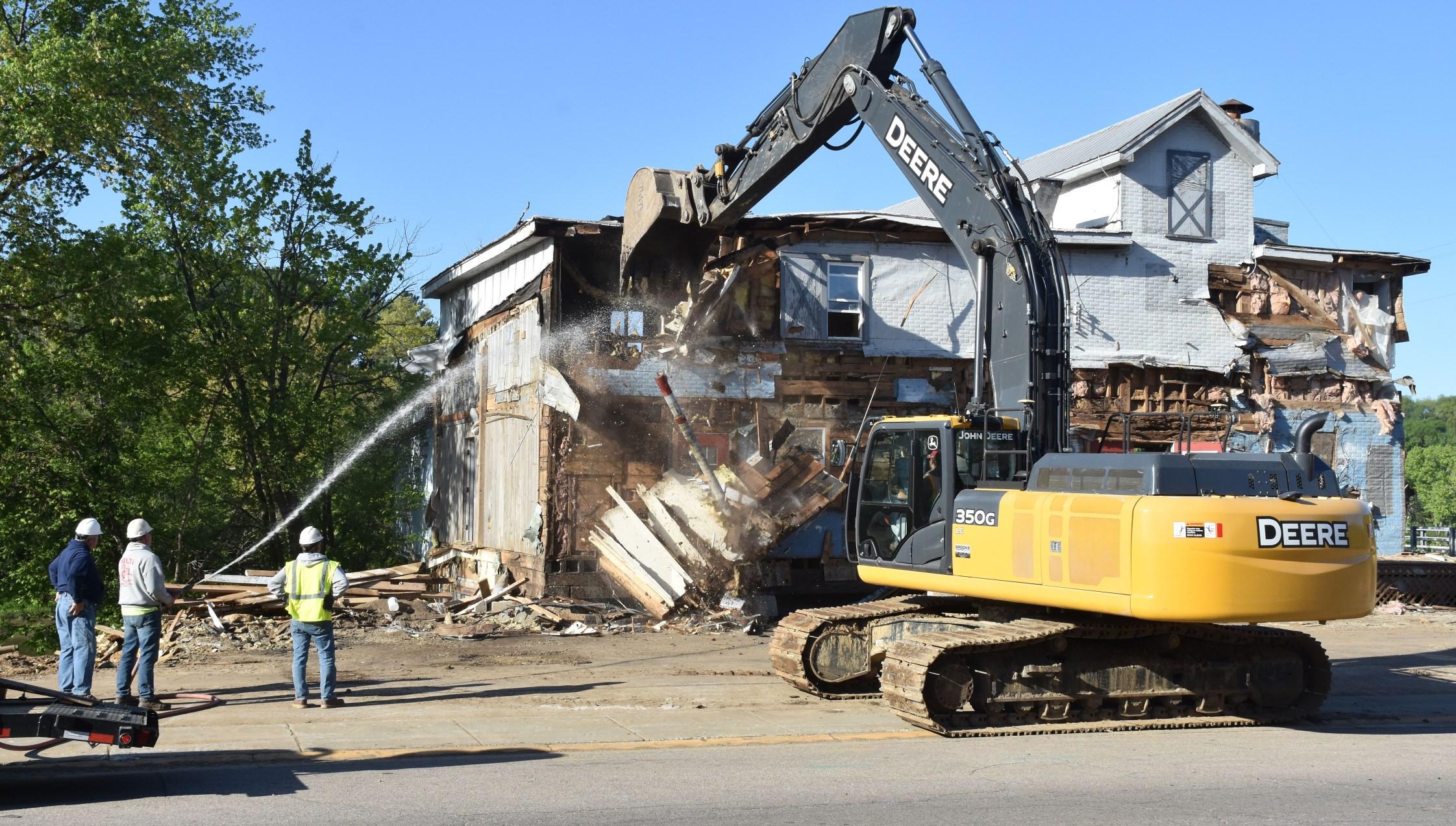

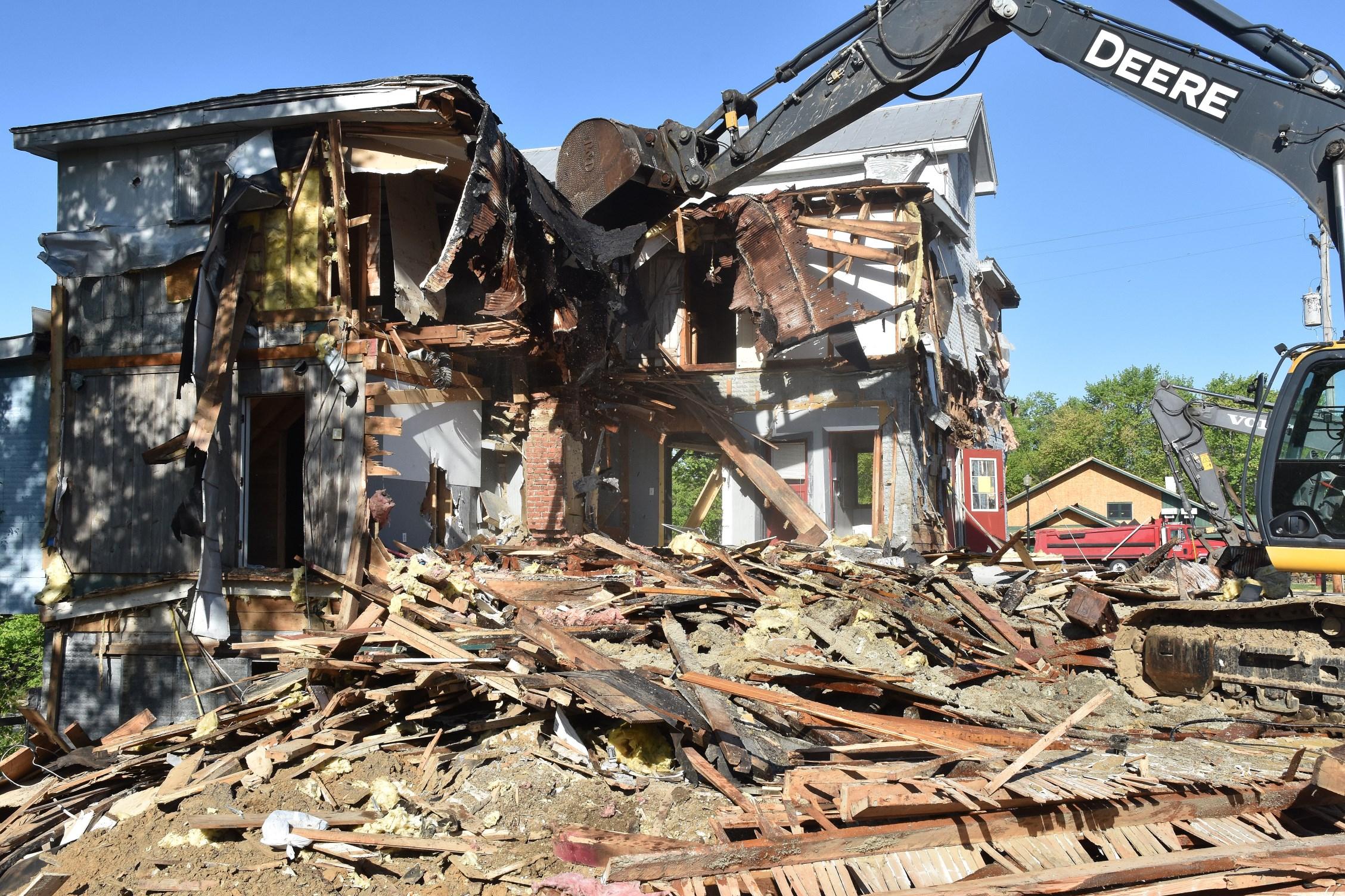 Water is sprayed on the debris to mitigate the dust.
Water is sprayed on the debris to mitigate the dust.





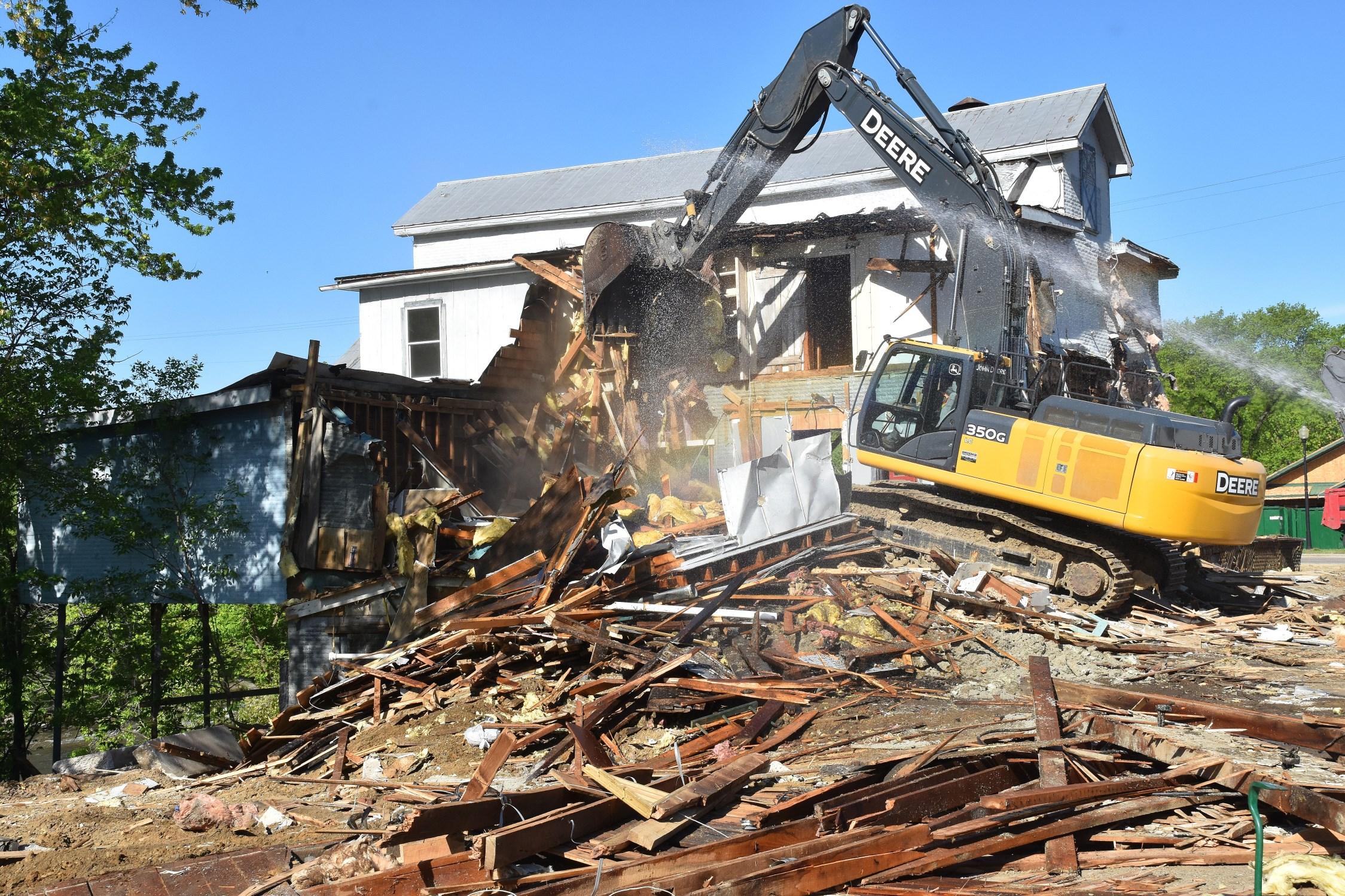



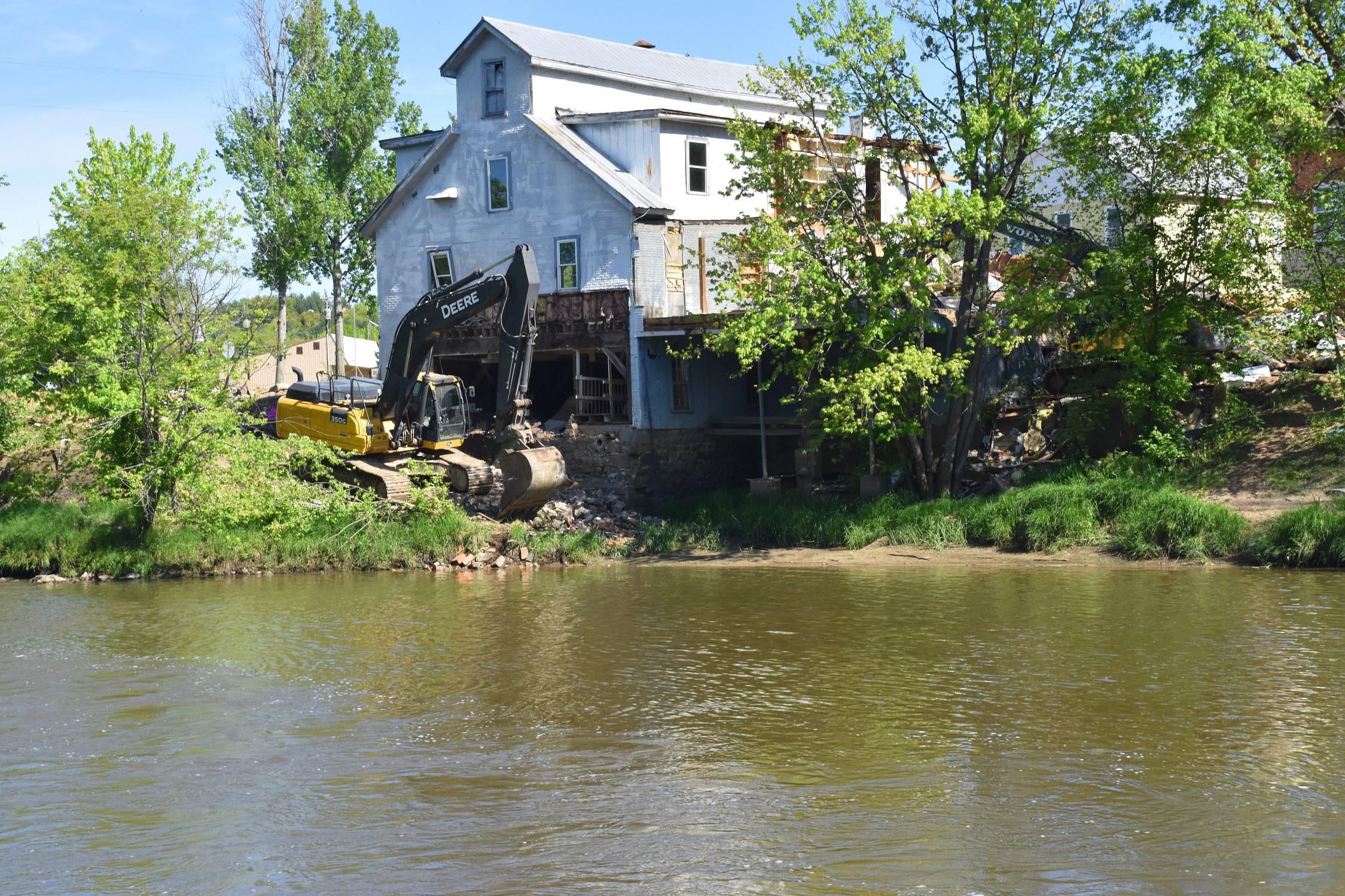





 Insert MP4 video of main section being pushed over.
Video # Mill Demolition
Insert MP4 video of main section being pushed over.
Video # Mill Demolition



 One gentle push, and the upper part of the old mill toppled over.
One gentle push, and the upper part of the old mill toppled over.





















 Some of the gears and shafts which were operated by the water wheel turbine were saved for future display.
The grain mixer from the mill, left and below, was removed and hauled away to be repurposed.
Some of the gears and shafts which were operated by the water wheel turbine were saved for future display.
The grain mixer from the mill, left and below, was removed and hauled away to be repurposed.
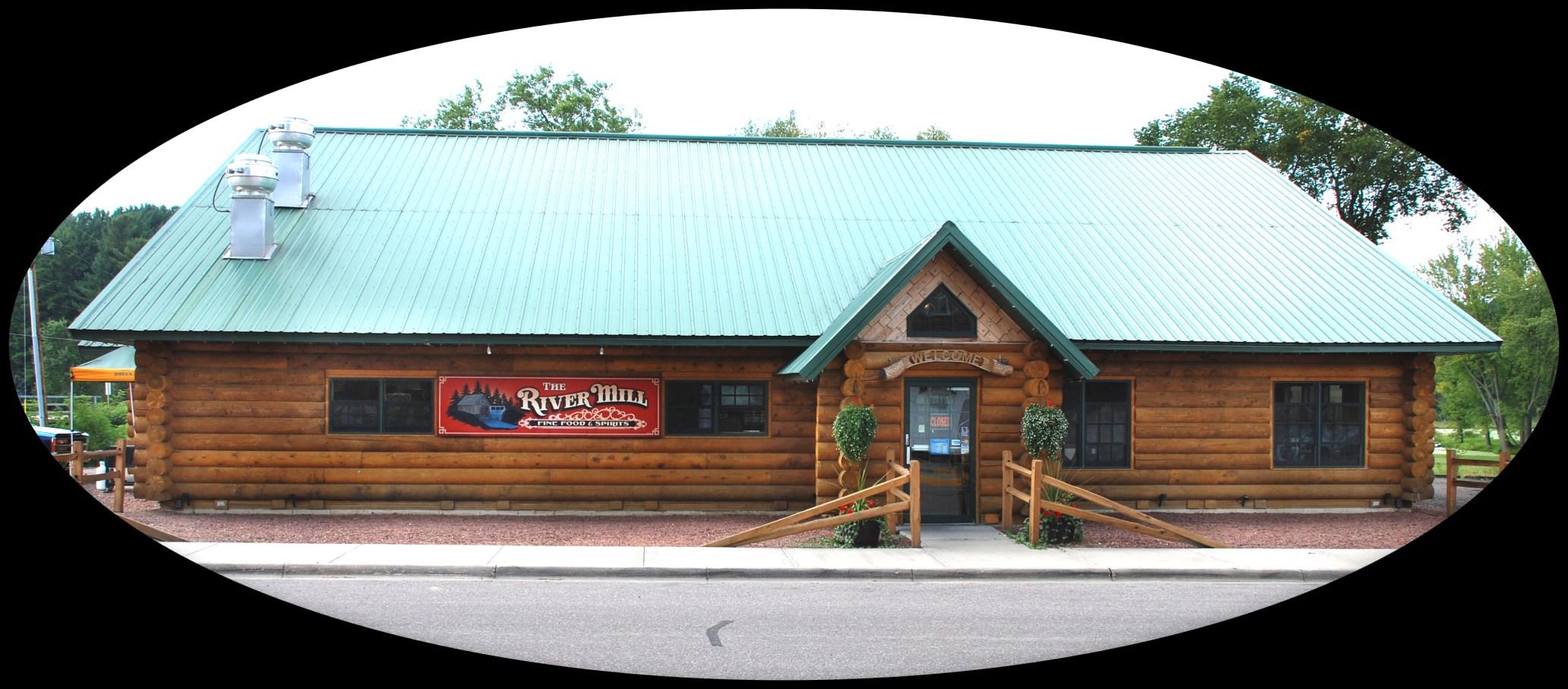

 The River Mill Bar and Restaurant in 2022
This Ford Garage, and post office on the left, were demolished to make room for the tavern that was later owned by the Rabuck’s in 1961. That tavern later became the first location of the River Mill Bar and Restaurant.
The River Mill Bar and Restaurant in 2022
This Ford Garage, and post office on the left, were demolished to make room for the tavern that was later owned by the Rabuck’s in 1961. That tavern later became the first location of the River Mill Bar and Restaurant.



 This original River Mill, above, burned down in early 2001. The new log River Mill was built here later that same year..
The Rabuck family owned the tavern from July, 1961, to June, 1987. It was then sold, and became the original River Mill Bar and Restaurant.
This original River Mill, above, burned down in early 2001. The new log River Mill was built here later that same year..
The Rabuck family owned the tavern from July, 1961, to June, 1987. It was then sold, and became the original River Mill Bar and Restaurant.
The River Mill in 2009, above and below. It was built in 1961, by Mike and Roxanne Margosian and opened in September 2001. It closed to the public in 2020\2021.





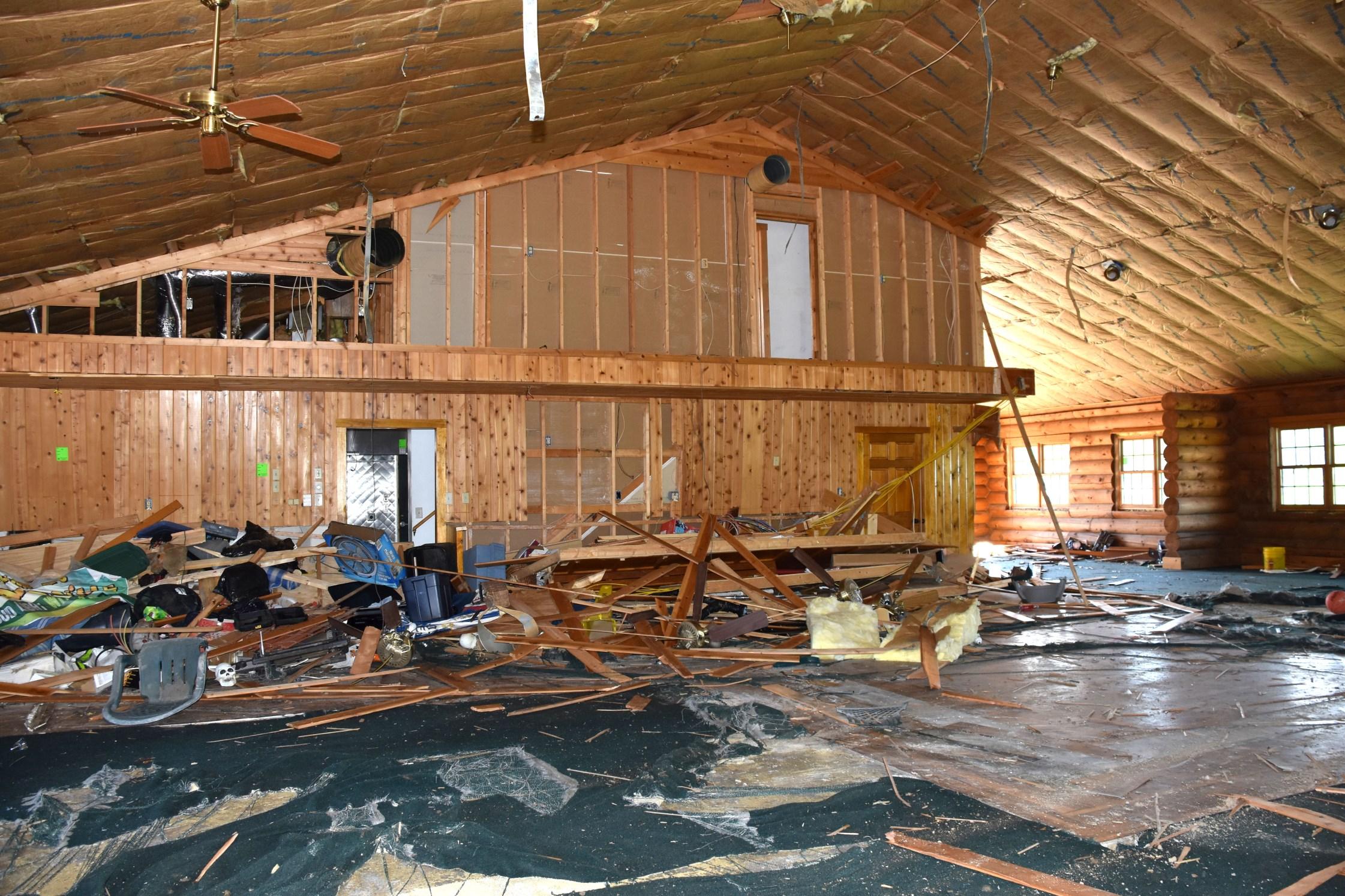

 The interior of the River Mill as deconstruction began.
The interior of the River Mill as deconstruction began.



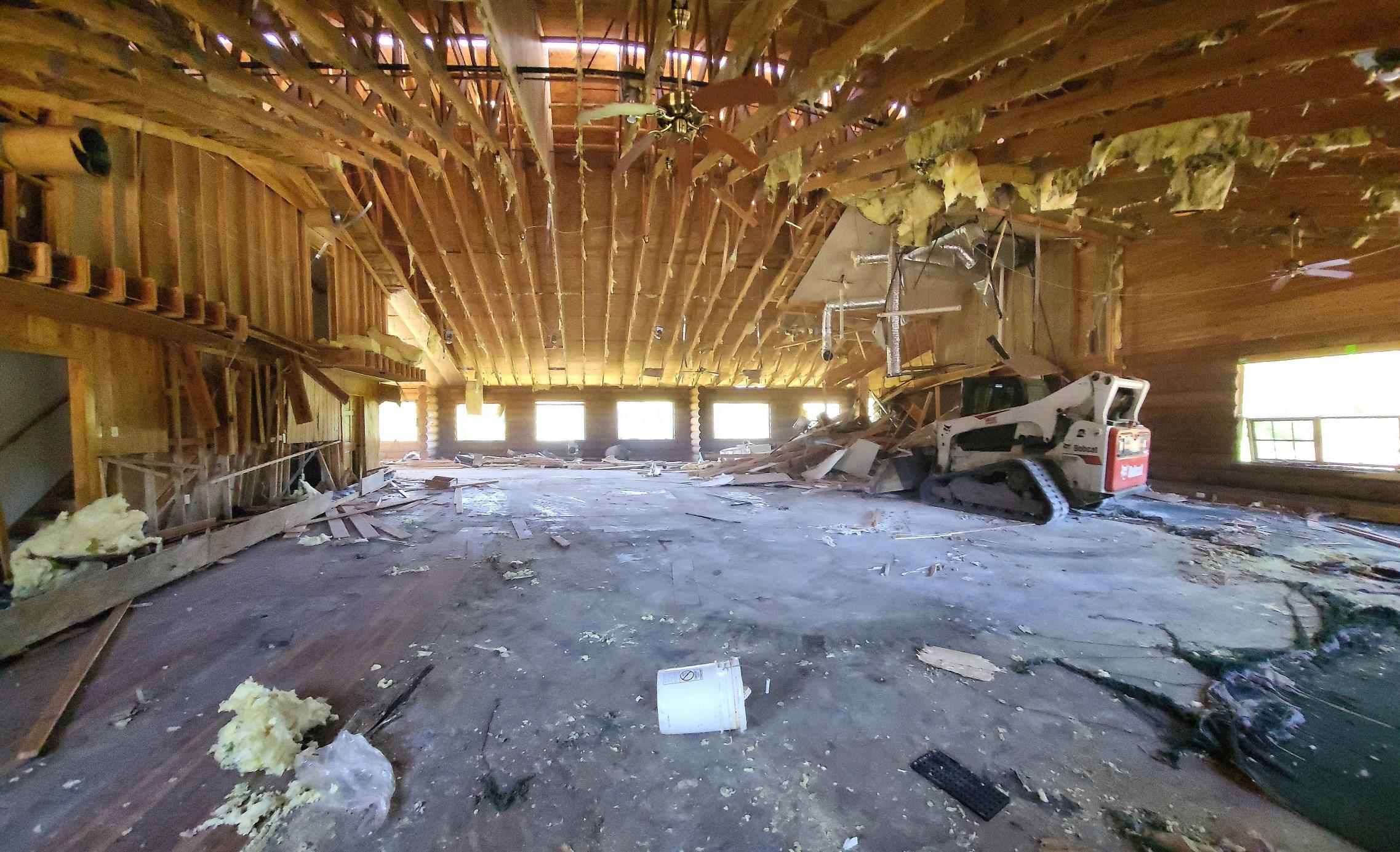


 The metal roofing of the River Mill Restaurant was repurposed.
The metal roofing of the River Mill Restaurant was repurposed.

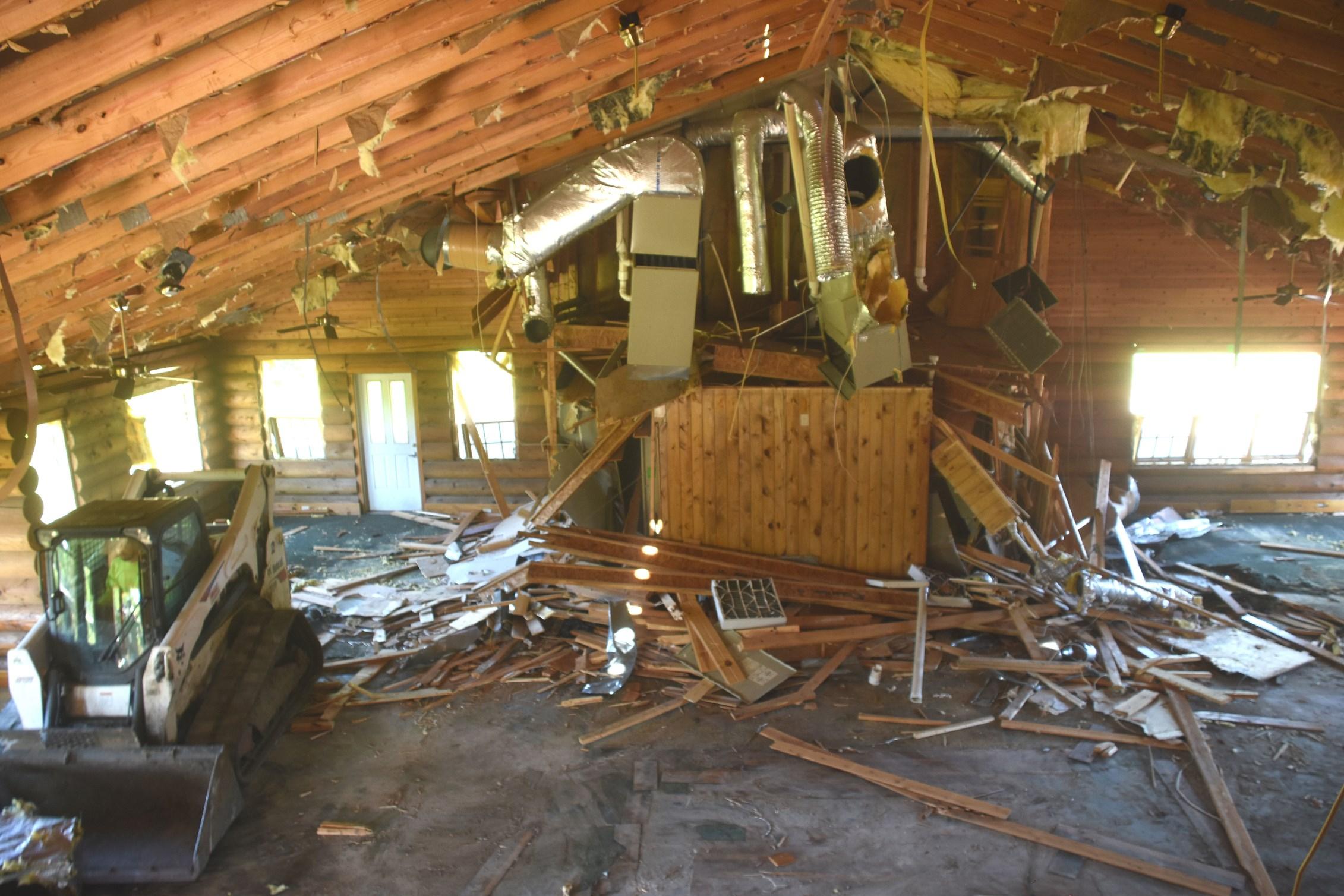


Insert MP4 video of furnaces being toppled
Video # River Mill Interior Deconstruction




The trusses, below, are being revealed to be salvaged and repurposed.



 Hauling away the debris from the interior of the River Mill Restaurant.
Hauling away the debris from the interior of the River Mill Restaurant.
The green lift, above, was used to facilitate the loosening of the trusses so that they could be removed


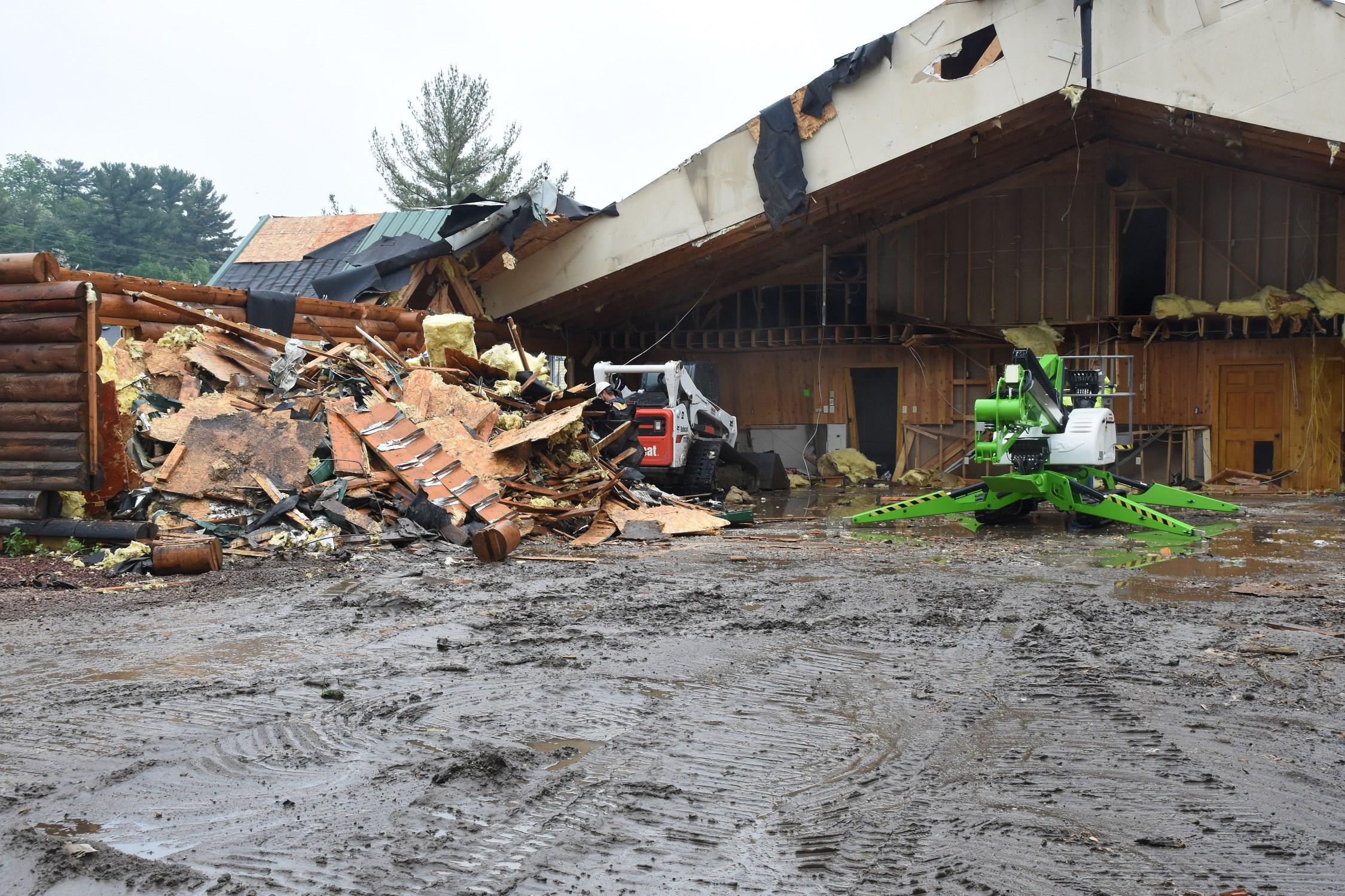

The trusses were salvaged to be repurposed.




MP4 Video of
Insert
trusses being removed Video # Truss Removal



 The entryway to the River Mill Bar & Restaurant was saved and repurposed (below)
The entryway to the River Mill Bar & Restaurant was saved and repurposed (below)







 The former location of the River Mill Restaurant is now a cement slab. July 2022
The former location of the River Mill Restaurant is now a cement slab. July 2022
Fellowship Evangelical Free Church, above in 2002. It was demolished in June 2022, left & below.





 This building was used as LaValle’s Post Office for a time, beginning in 1961.
This building was used as LaValle’s Post Office for a time, beginning in 1961.
Donna’s Antiques as it looked in 1999, above, and below in 2002. The building was ultimately purchased by the DNR when it was condemned, and sat vacant and dilapidated until it was torn down in June, 2022. The building was also used by the Oakdale Electric Company, ca. early 1970s.







 Donna’s Antiques, as it looked in June 2022.
Donna’s Antiques, as it looked in June 2022.

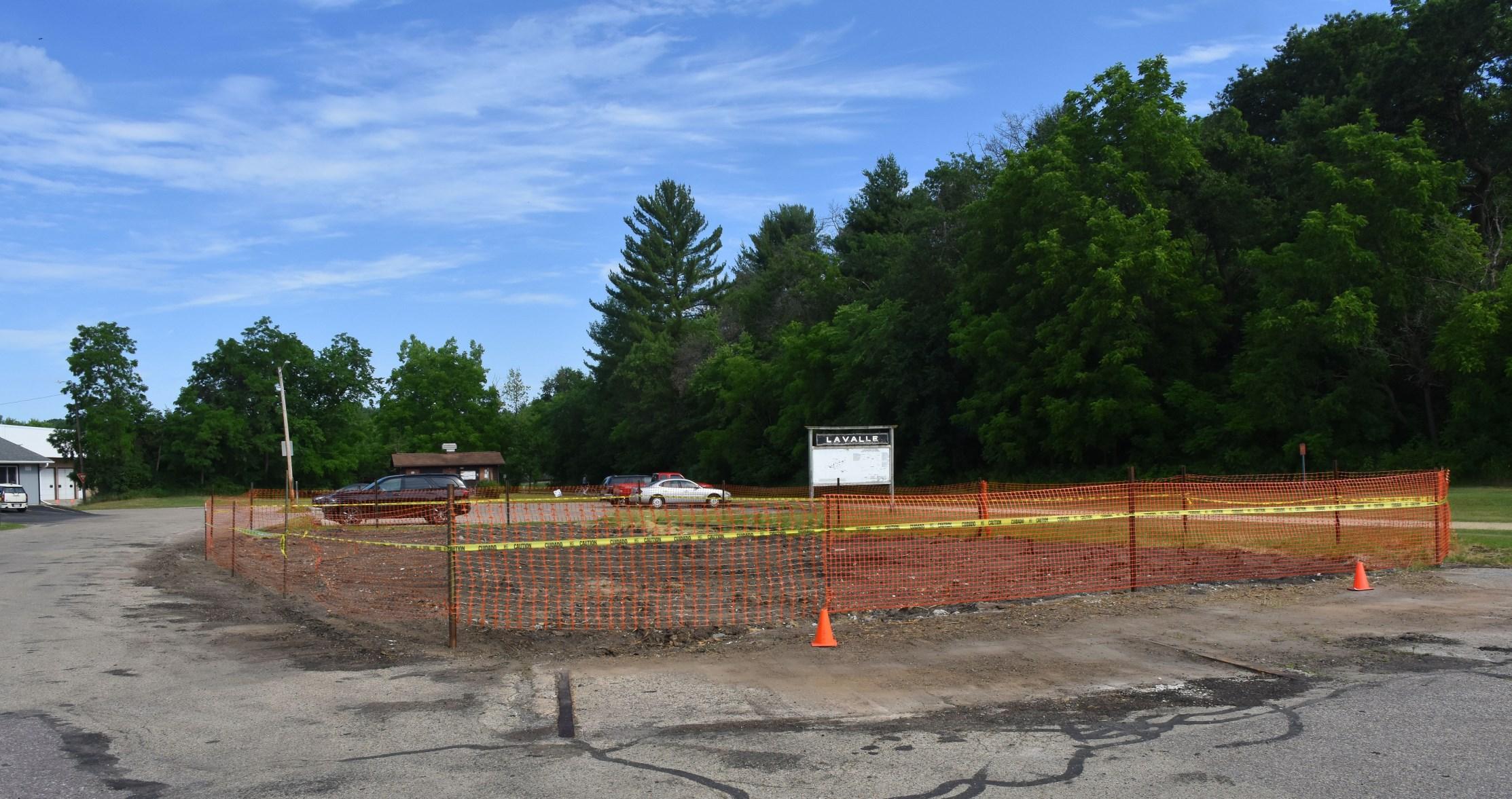

 Only the footprint of the antique store remains in July, 2022
In June, 2022, the building was taken down.
Photo above, by Kyra Seamans
Only the footprint of the antique store remains in July, 2022
In June, 2022, the building was taken down.
Photo above, by Kyra Seamans
After all the work was completed in removing the buildings along the Baraboo River, the following photos show how the riverbank looks in July, 2022.







 Straw covers the newly seeded ground along the Baraboo River.
Straw covers the newly seeded ground along the Baraboo River.




We wish to thank the following:
Holtz Lime & Gravel Excavating, Inc. of Loganville

Darrell Schlieckau, Demolition Contractor
Ryan Rabuck, vintage photos & buildings history
Kyra Seamans, photo
Beverly Vaillancourt, research
Sauk County Historical Society, vintage photographs
The Village of LaValle, Wisconsin
 Google Earth Map September 12, 2017
LaValle, Wisconsin
Google Earth Map September 12, 2017
LaValle, Wisconsin
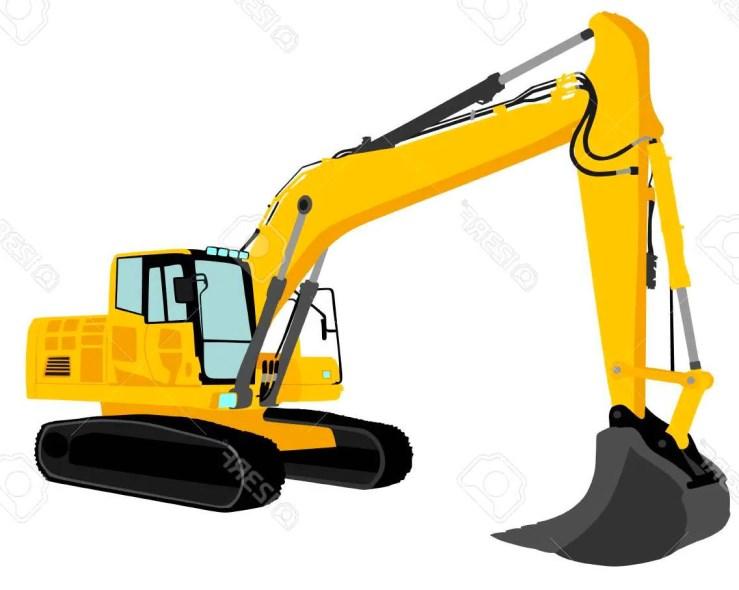

 By William C. Schuette
By William C. Schuette



















 The Library and Village Hall before it was deconstructed in 2009. Wollin’s Grocery store was destroyed by fire in 2016.
The Library and Village Hall before it was deconstructed in 2009. Wollin’s Grocery store was destroyed by fire in 2016.



 Abandoned buildings and Granny’s Pantry Restaurant before their deconstruction in June, 2022
Abandoned buildings and Granny’s Pantry Restaurant before their deconstruction in June, 2022



 The Treasure Mill, above, and the Old Kreutzmann Saloon as they looked before their deconstruction.
The Treasure Mill, above, and the Old Kreutzmann Saloon as they looked before their deconstruction.



 The River Mill Restaurant and Electrical Power House.
The River Mill Restaurant and Electrical Power House.

 The Library and Village Hall as it looked in 1999.
The Library and Village Hall as it looked in 1999.



 Photos by Ryan Rabuck 2009
The former library and city hall was taken down in 2009
Photos by Ryan Rabuck 2009
The former library and city hall was taken down in 2009




 Photos by Ryan Rabuck
2016
The building was totally destroyed by fire in 2016
Photos by Ryan Rabuck
2016
The building was totally destroyed by fire in 2016







 The Old Legion Building as it appeared in 2002.
The Old Legion Building as it appeared in 2002.



 The old Legion building is being taken down, beginning at the rear.
The old Legion building is being taken down, beginning at the rear.




 The Daisy Restaurant was once housed in the building above, and on the previous two pages.
History of Reedsburg & the Upper Baraboo Valley Merton Krug, 1929
Garage, located at the rear of the old Legion building.
Above, the old Legion building coming down.
The Daisy Restaurant was once housed in the building above, and on the previous two pages.
History of Reedsburg & the Upper Baraboo Valley Merton Krug, 1929
Garage, located at the rear of the old Legion building.
Above, the old Legion building coming down.






 This private home along the river, was demolished in June, 2022.
This private home along the river, was demolished in June, 2022.




























 Above is the restaurant lunch counter. Below, is one of the upstairs rooms, in June, 2022, just before the building was demolished.
Above is the restaurant lunch counter. Below, is one of the upstairs rooms, in June, 2022, just before the building was demolished.







 Granny’s Pantry as it is taken down by this excavator.
Granny’s Pantry as it is taken down by this excavator.



 The elevator cable mechanism, below, which lifted the caskets to the second floor.
The elevator cable mechanism, below, which lifted the caskets to the second floor.



 Water is sprayed on the debris, below, to keep the dust down.
Water is sprayed on the debris, below, to keep the dust down.









 At the rear of the old mill, this building housed the water wheel (below it) and the gearing system, inside, which transferred belt power to operate the mill. The Baraboo River flows on the right.
At the rear of the old mill, this building housed the water wheel (below it) and the gearing system, inside, which transferred belt power to operate the mill. The Baraboo River flows on the right.



 Photos from the collection of Sandy Cole
Photos from the collection of Sandy Cole





 This diagram represents the way the turbine water wheel and gearing system operated to produce power to run the mill equipment and electrical generator.
Turbine
Control Shaft
Power Shaft
Pully which contained a belt that powered the mill equipment
Gate which controlled the river water which flowed past the water wheel turbine
This diagram represents the way the turbine water wheel and gearing system operated to produce power to run the mill equipment and electrical generator.
Turbine
Control Shaft
Power Shaft
Pully which contained a belt that powered the mill equipment
Gate which controlled the river water which flowed past the water wheel turbine


 This building housed the gears above the water wheel.
This building housed the gears above the water wheel.



 The teeth in this power transfer gear were made of wood.
The teeth in this power transfer gear were made of wood.


 The gear on the far right is turned by the water wheel, which then transfers that motion to the horizontal gear shaft. Pullies on the shaft then transfer that rotary motion to various equipment in the mill.
An indoor toilet was one of the luxury features inside the old mill.
The gear on the far right is turned by the water wheel, which then transfers that motion to the horizontal gear shaft. Pullies on the shaft then transfer that rotary motion to various equipment in the mill.
An indoor toilet was one of the luxury features inside the old mill.







 The turbine water wheel which powered the equipment in the mill.
The turbine water wheel which powered the equipment in the mill.


 Above, the basement of the mill. Below, the top half of a grain mixer.
Above, the basement of the mill. Below, the top half of a grain mixer.

 Rooms inside the Mill
Rooms inside the Mill




 Bottom half of the grain mixer.
Bottom half of the grain mixer.









 Demolition of the exterior of the Mill begins.
Demolition of the exterior of the Mill begins.









 The scattered lumber from the Mill was reclaimed and repurposed.
The scattered lumber from the Mill was reclaimed and repurposed.



















 Reclaiming the boards and timbers for recycling, below.
Reclaiming the boards and timbers for recycling, below.











 Water is sprayed on the debris to mitigate the dust.
Water is sprayed on the debris to mitigate the dust.












 Insert MP4 video of main section being pushed over.
Video # Mill Demolition
Insert MP4 video of main section being pushed over.
Video # Mill Demolition



 One gentle push, and the upper part of the old mill toppled over.
One gentle push, and the upper part of the old mill toppled over.



















 Some of the gears and shafts which were operated by the water wheel turbine were saved for future display.
The grain mixer from the mill, left and below, was removed and hauled away to be repurposed.
Some of the gears and shafts which were operated by the water wheel turbine were saved for future display.
The grain mixer from the mill, left and below, was removed and hauled away to be repurposed.


 The River Mill Bar and Restaurant in 2022
This Ford Garage, and post office on the left, were demolished to make room for the tavern that was later owned by the Rabuck’s in 1961. That tavern later became the first location of the River Mill Bar and Restaurant.
The River Mill Bar and Restaurant in 2022
This Ford Garage, and post office on the left, were demolished to make room for the tavern that was later owned by the Rabuck’s in 1961. That tavern later became the first location of the River Mill Bar and Restaurant.



 This original River Mill, above, burned down in early 2001. The new log River Mill was built here later that same year..
The Rabuck family owned the tavern from July, 1961, to June, 1987. It was then sold, and became the original River Mill Bar and Restaurant.
This original River Mill, above, burned down in early 2001. The new log River Mill was built here later that same year..
The Rabuck family owned the tavern from July, 1961, to June, 1987. It was then sold, and became the original River Mill Bar and Restaurant.






 The interior of the River Mill as deconstruction began.
The interior of the River Mill as deconstruction began.





 The metal roofing of the River Mill Restaurant was repurposed.
The metal roofing of the River Mill Restaurant was repurposed.









 Hauling away the debris from the interior of the River Mill Restaurant.
Hauling away the debris from the interior of the River Mill Restaurant.










 The entryway to the River Mill Bar & Restaurant was saved and repurposed (below)
The entryway to the River Mill Bar & Restaurant was saved and repurposed (below)






 The former location of the River Mill Restaurant is now a cement slab. July 2022
The former location of the River Mill Restaurant is now a cement slab. July 2022





 This building was used as LaValle’s Post Office for a time, beginning in 1961.
This building was used as LaValle’s Post Office for a time, beginning in 1961.







 Donna’s Antiques, as it looked in June 2022.
Donna’s Antiques, as it looked in June 2022.



 Only the footprint of the antique store remains in July, 2022
In June, 2022, the building was taken down.
Photo above, by Kyra Seamans
Only the footprint of the antique store remains in July, 2022
In June, 2022, the building was taken down.
Photo above, by Kyra Seamans







 Straw covers the newly seeded ground along the Baraboo River.
Straw covers the newly seeded ground along the Baraboo River.




 Google Earth Map September 12, 2017
LaValle, Wisconsin
Google Earth Map September 12, 2017
LaValle, Wisconsin